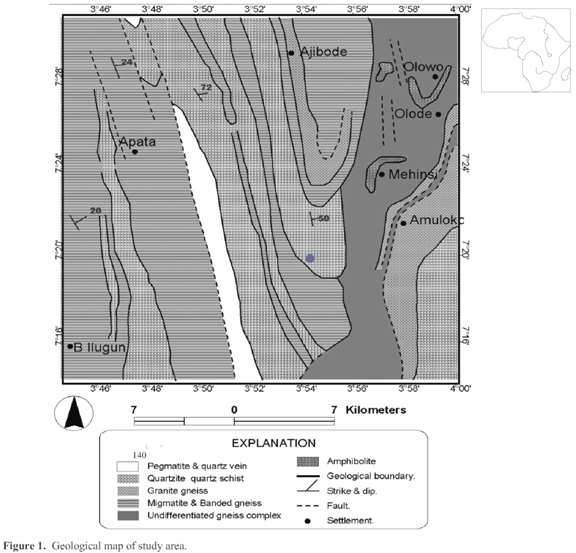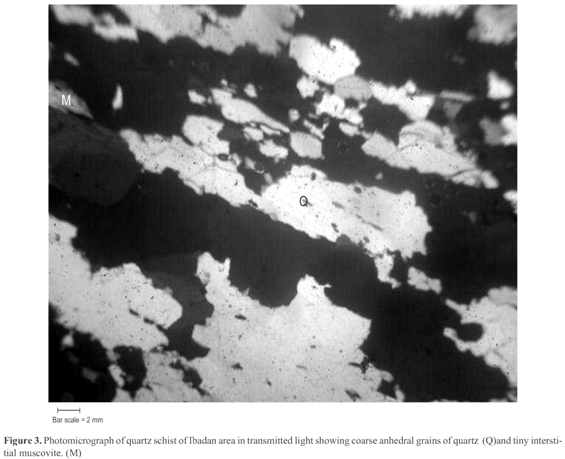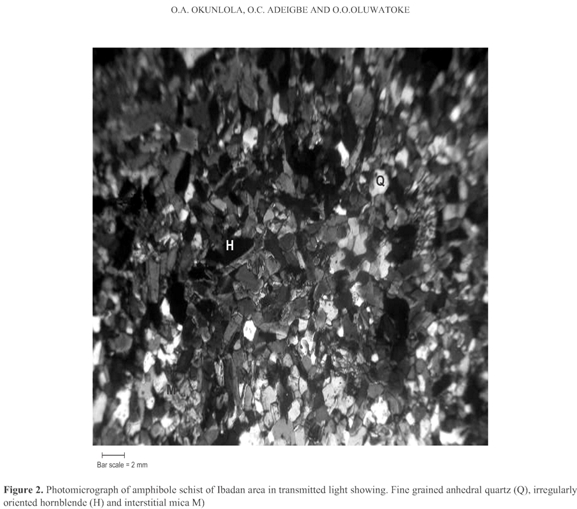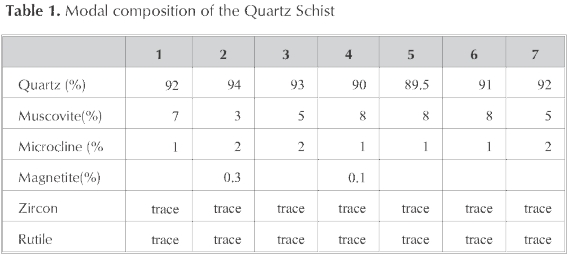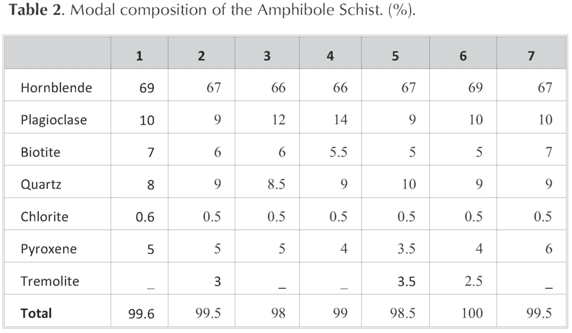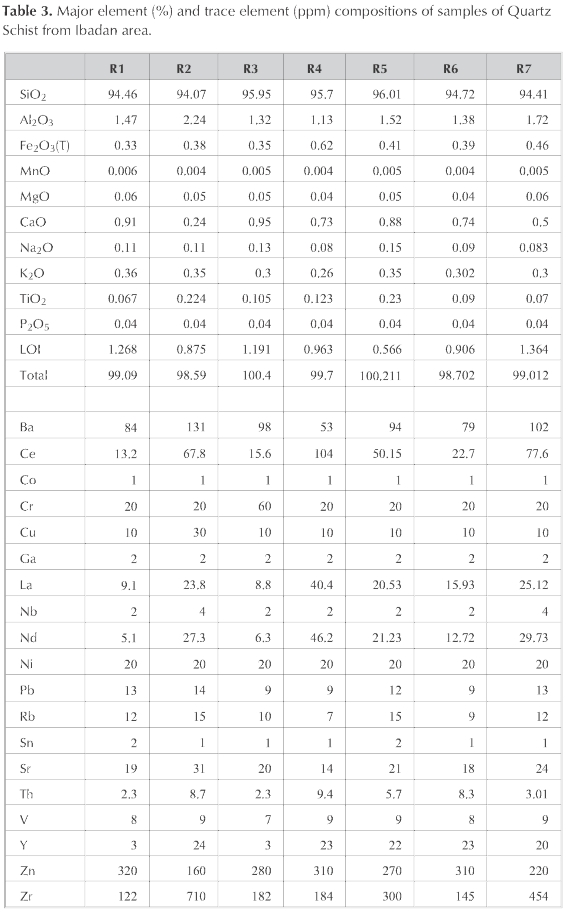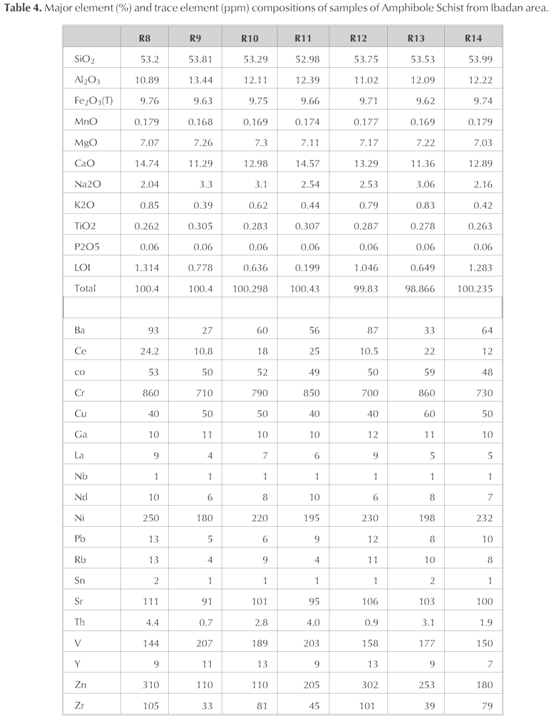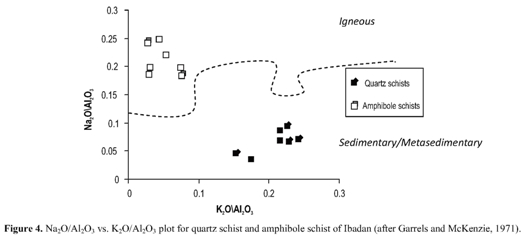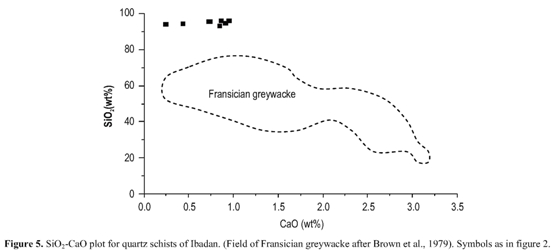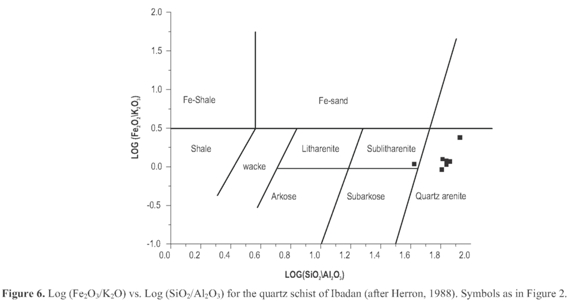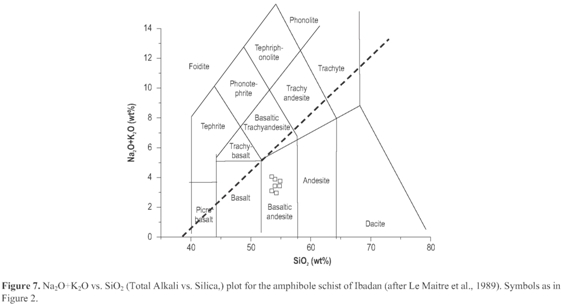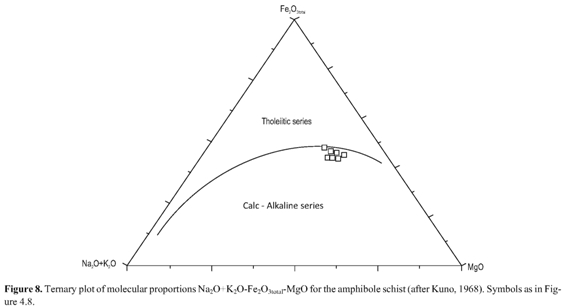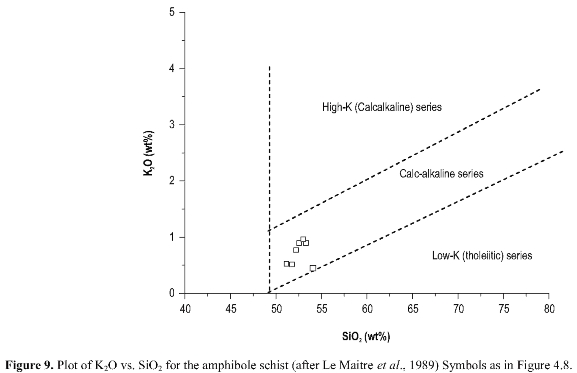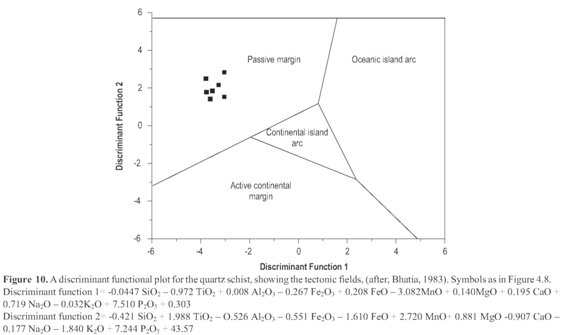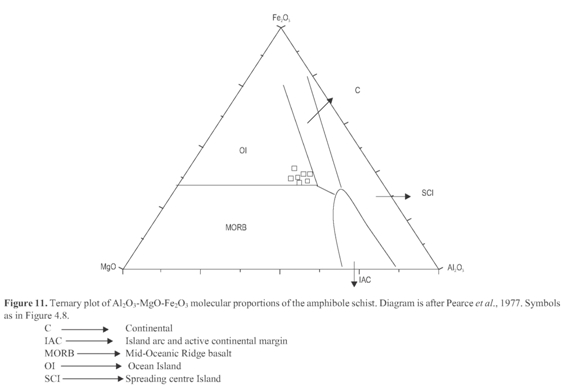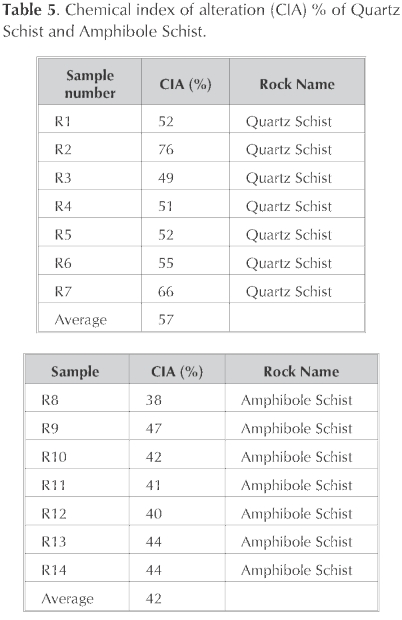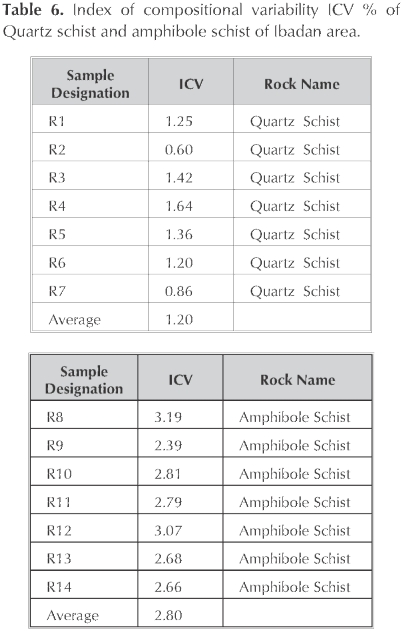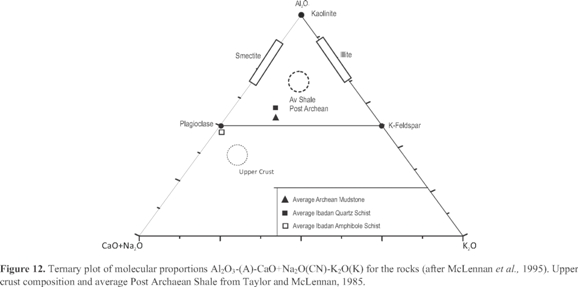Serviços Personalizados
Journal
Artigo
Indicadores
-
 Citado por SciELO
Citado por SciELO -
 Acessos
Acessos
Links relacionados
-
 Citado por Google
Citado por Google -
 Similares em
SciELO
Similares em
SciELO -
 Similares em Google
Similares em Google
Compartilhar
Earth Sciences Research Journal
versão impressa ISSN 1794-6190
Earth Sci. Res. J. v.13 n.2 Bogotá jul./dez. 2009
COMPOSITIONAL AND PETROGENETIC FEATURES OF SCHISTOSE ROCKS OF IBADAN AREA, SOUTHWESTERN NIGERIA
O.A. Okunlola, O.C. Adeigbe and O.O.Oluwatoke
Department of Geology, University of Ibadan Nigeria gbengaokunlola@yahoo.co.uk
Manuscript received: 13/05/2009 Accepted for publication: 10/12/2009
ABSTRACT
Amphibole and quartz schist which occur in association with migmatite gneiss, granitic gneiss and Pan African Older Granite bodies around Ibadan area, southwestern Nigeria, were studied with a view to elucidate their compositional characteristics and their evolution.
Mineralogical determinations from optical studies show a high proportion of granular quartz and accessory muscovite in the quartz schist. The amphibole schist on the other hand comprises mainly dark colored bands of hornblende with subordinate tremolite, chlorite and minor amounts of plagioclase and quartz.
Chemical analysis of the samples obtained by Inductively Coupled Plasma Mass Spectrometry (ICPMS) instrumentation method, involving major and trace elements reveal the silicieous nature of the quartz schist and and the amphibole .samples of both rock units are also marked by relatively elevated contents of Ba, Zr, Rb, La and Ce and Zr. In addition, variation plots using Na2O, K2O suggests arenaceous sedimentary ancestry for the quartz schist and an igneous ancestry most probably mafic extrusive volcanics for the amphibole schist. Provenance indicators, such as Ba, in the quartz schists suggest derivation of this sedimentary protolith from the weathering of largely granitic rocks. Similarity of the amphibole schist progenitors with subalkaline basaltic andesite is also implied by the Na2O+K2Oversus SiO2 bivariate plot, while the Na2O+K2O-Fe2O3(t)-MgO ternary plot reveal their calc-alkaline affinity. Tectonically, the quartz schists evolved within the passive margin environment, whereas the MgO-Fe2O3-Al2O3 ternary plots reveal an Ocean island basalt tectonic evolution for the amphibole schist.
Key words: Amphibole, Quartz, Schist, Schistose rocks, Ibadan-Nigeria, Petrogenetic
RESUMEN
Anfíboles y esquistos de cuarzo que ocurren en asociación con gneiss migmatiticas, gneiss de granito y cuerpos antiguos de granito Pan Africano alrededor del área de Ibadan, a sudoeste de Nigeria, fueron estudiados con el fin de aclarar las características composicionales y su evolución.
Determinaciones mineralógicas a partir de estudios ópticos muestran una alta proporción de cuarzo granular y moscovita accesorios en el esquistos de cuarzo. Por otro lado, los esquistos anfíboliticos incluyen bandas de color oscuro principalmente de hornblenda con tremolita, clorito y de pequeñas cantidades de plagioclasa y cuarzo.
El análisis químico de las muestras obtenidas por el método acoplamiento inductivo de Espectrometría de Masas (ICPMS), revela la naturaleza de silicieous de los esquistos de cuarzo y los anfíboliticos. Muestras de ambas unidades de rocas también están marcados por el contenido relativamente elevado de Ba, Zr, Rb, La y Ce y Zr. Además, la variación de las gráficas Na2O, Al2O, K2O sugiere arenas sedimentarias antiguas para el esquisto de cuarzo y una ígnea antigua muy probablemente mafica para los esquistos anfíboliticos. Los indicadores de procedencia, tales como Ba, enlos esquistos de cuarzo sugierenderivación de protolito sedimentario desde la erosión de las rocas graníticas en gran medida. La similaridad entre los progenitores de esquisto anfíboliticos con andesita basáltica subalkaline también implican Na2O+K2O versus SiO2, por la variación de la gráfica Na2O+K2O-Fe2O3 (t)- MgO revelan su afinidad calco-alcalinas. Tectónicamente, los esquistos de cuarzo evolucionaron en un ambiente de margen pasivo, mientras que el gráfico MgO-Fe2O3-Al2O3 parcela ternario revelan una evolución tectónica basalto en la isla de Océano para los esquistos anfíboliticos.
Palabras clave: Anfíboles, Cuarzo, Esquistos, Schistose rocks, Ibadan-Nigeria, Petrogenetic.
Introduction
The Nigerian Basement Complex which occurs within the Neoproterozoic to Early Paleozoic, Pan-African (ca 0.6 Ga.) province east of the West African Craton is loosely classified into three principal subdivisions. These are the ancient migmatite-gneiss-quartzite complex, the schist belts and the Pan-African (ca 600 Ma.) granitic series (Elueze and Okunlola, 2003).
The migmatite gneiss suites are mainly ca 2.8 to 2.0 Ga. ages. Most authors on the Nigerian Basement Complex subscribe to the view that the rocks of these suites comprise largely a sedimentary series with associated minor igneous rocks which has been variably altered by meta-morphic, migmatic and granitic processes (Oyawoye, 1972; Rahaman, 1988; Okunlola, 2005).
A number of north-south trending Proterozoic schist belts occur conspicuously within the western part of Nigeria with few in the eastern parts and show distinctive petrological and structural features. Fourteen of such belts have been delineated (Rahaman, 1976; Odeyemi, 1977; Ekwueme and Shing1987; Elueze, 1991; Okunlola, 2001; Elueze and Okunlola, 2003).
Belts in the southwest include Iseyin, Igarra, Egbe ,Isanlu, Ife-Ilesha,, lokoja -Jakura, and Toto-Gadabuike. As at now however, there is no complete agreement on location, delimitation, geological nomenclature and geodynamic setting of the Nigerian schist belt.
These schistose rocks occurrences around Ibadan constitute the southern extension of the N-S trending Iseyin Oyan belt. This study hence aims at elucidating the compositional features and hence petrogenetic affinity of these schistose rocks of Ibadan area. This is expected to further lead to the understanding of the geodynamic evolution of the schist belts and the Precambrian of Nigeria.
Lithological association and petrography
In the study area, the schistose rocks are associated with an almost north- south trending unit of the migmatite gneiss complex. The contacts are tectonic in places with prominent slickenside features and cataclastites. These units were later intruded by Pan-African granitic rocks of adammellitic and peg-matitic varieties. These schistose rocks are mainly quartz schist and amphibole schist. The quartz schist form prominent features especially west of Ajibode and Sango area (Fig. 1). Their outcrop pattern indicates possibly a refolded fold (Fig. 1). They are usually fine grained and form extensive north -south trending bodies. In places, they are characterized by preponderance of quartz rubbles and usually whitish grey in color. But in areas of prominent iron staining as a result of thick overlying lateritic regolith they are usually brownish gray in color. They are the most extensive of the schistose rocks studied.
Under the microscope, the rock unit is composed mainly of quartz and muscovite (Fig. 3) Quartz occurs as cloudy anhedral grains with characteristic weak birefringence, prominent undulose extinction and low relief while muscovite occurs as tiny elongate plates with poikilitic crystals of quartz. The amphibole schists on the other hand occur in places as greenish, fissile bodies sometimes weathered or as lenticular and sometimes ovoid shaped bodies comprising of indistinct dark colored bands of greenish black amphibole, light colored bands of plagioclase and minor quartz. Thin section study reveals that the amphiboles are mainly hornblende, tremolite and chlorite.
(Fig. 2) Quartz and plagioclase occur in minor proportions with accessory biotite and zircon. Hornblende occurs as small xenoblastic crystals, greenish in color while tremolite grains tend to be long, prismatic and usually pleichroic from pale green to dark green. Quartz occurs as small anhedral grains with wavy extinction. The Modal composition of the quartz schist and amphibole schist are shown in tables 1 and 2.
Geochemical Features
Samples and Analytical Techniques
Seven unaltered and fresh samples each of quartz schist and amphibole schist were analyzed for both major oxide and trace element concentrations at the Activation Laboratories, Canada, using the inductively coupled plasma analytical technique. Analytical results are presented in tables 3 and 4.
Discussion of Results
Average SiO2 value in the quartz schist is high (95%). This is comparable to values obtained for most quartz schist samples of the Nigerian metasedimentary belt (Okonkwo, 1992; Elueze and Okunlola, 2003; Okunlola, et.al., 2006). Conversely, the average SiO2 values in the amphibole schist (53.5%) is expectedly much lower and also lower than those of the average values of schistose amphibolites of Nigeria (Ajayi, 1980; Elueze, 1985; Elueze and Okunlola, 2003b). Fe2O3 values in the samples of the quartz schist range from 0.33%- 0.62% with a mean of 0.42% while in the amphibole schists they range from 9.63%-9.76% with a mean concentration of 9.7%. The comparatively lower Fe2O3 values in the quartz schist are due to the almost total absence of melanocratic minerals. The values for the amphibole schist are comparable to those of the schistose amphibolite varieties of Burum metabasalts while it is lower than those of the banded and massive varieties of the same area (Elueze and Okunlola, 2003).
The average K2O, Na2O and CaO values are greater in the amphibole schist (0.62%, 2.67% and 13.0% respectively) compared to those of the quartz schists (0.32%, 0.11% and 0.71% respectively). These K2O and Na2O values for the amphibole schist are higher compared with most of the schistose amphibolite samples of Nigeria which are of tholeiitic affinity. However, for the quartz schist they are within limits for metasedimentary rocks (Okonkwo and Winchester, 1992.)
The average values of MgO and TiO2 for the quartz schist are low (both less than 0.06%)
Similarly, the average value for these oxides for amphibole schist at 7.17% and 0.29% respectively are also lower than those of tholeiitic basalts of Nigeria and those of the average values for Holleindain Archean metabasalts (Jahn et.al, 1974).
Average value for the quartz schist is 0.13% while that of the amphibole schist is 0.28%.
Provenance of the protolith and tectonic Setting
The Na2O/Al2O3 against K2O/Al2O3 plot (Fig. 4) (Garrels and McKenzie, 1971) shows the entire quartz schist samples plot in the sedimentary/metasedimentary field while the amphibole schists plot in the igneous /metaigneous field. This suggests clear distinct genesis for the protoliths for these rock units. The provenance of sedimentary rocks is usually inferred from the framework constituents of the rocks (Pettijohn, 1975; Potter, 1978; Dickinson and Vallani, 1980; Okonkwo, 2005) From the relatively low content of Ba, Rb and Sr in samples of the quartz schist (Table 3) there is a strong possibility of a sedimentary source depleted in arkosic composition, although the contribution onofa felsic source is not ruled out (Van de Kamp and Leake, 1986; Okonkwo and Winchester, 1996; Okonkwo, 2005). This is further supported by the plot of samples outside and above the field of Franscisian greywacke on the SiO2 versus CaO diagram of Brown et al, 1979. (Fig. 5). This shows that the protolith is not of a greywacke type. The plot of log (Fe2O3/K2O) versus log (SiO2/Al2O3) diagram (Herron, 1988) (Fig. 6), shows most of the quartz schist plot in the quartz sandstone field thus defining a quartz sandstone protolith for the samples.
For the amphibole schist, the total alkali versus silica plot of Le Maitre et.al. (1989) (Fig. 7) reveal samples plotting in the basaltic andesite field indicating a protolith intermediate between basalt and andesite in composition. The bold dash lines in figure 7 shows that the amphibole schist all plots in the subalkaline series (Macdonald, 1968). The Na2O+K2O-Fe2O3(t)-MgO ternary plot (Fig. 8) after Kuno (1968) further discriminates the samples as having a calc alkaline affinity, This is further confirmed by the K2O versus SiO2 plot (Fig. 9) after Le Maitre et al (1989).This shows that the amphibole schist of Ibadan area have a distinct petrogenetic character from most of the amphibolitic rocks of the basement complex of Nigeria which are mostly tholeiitic with Archean metabasalt affinity (Ajayi et.al., 1980; Elueze, 1980; Okonkwo, 1992; Okunlola and Elueze, 2003; Okunlola et.al., 2006)
Tectonically, the quartz schist samples plots as passive margin rocks on a discriminant function diagram after Bhatia (1983). (Fig. 10) The amphibole schists samples on the other hand, plot in the ocean island field on the MgO-Fe2O3 (t)-Al2O3 ternary plot after Pearce et al (1977) (Fig. 11).
Source Rock Weathering and Sediment Maturity of the Protolith
The chemical index of alteration (CIA) (Nesbitt and Young 1982) defined as CIA= [AhO3/(Al2O3 + CaO + N2O + K2O)] *100 has been used to determine the degree of weathering of the protolith of the rocks in the study area. The quartz schist samples have an average CIA value of 57% (Table 5) whereas those of the amphibole schist record an average value of 42%. This indicates a relatively moderate weathering of the source rocks. In comparison, quartz schists from Igarra area have an average CIA value of53.9% (Okeke and Meju, 1985) and those of Jakura area (Elueze and Okunlola, 2003) have an average value of 62.1%. Therefore the protoliths of the Ibadan quartz schists show fairly higher degree of weathering than those of the Igarra schist and conversely a lower degree than those of the Jakura schists. The differential weathering degree is further confirmed by the ternary plot of molecular proportions: Al2O3 (A) - CaO +Na2O (CN) - K2O (K) (Fig. 10) after McLennan et al. (1985), the quartz schists plot between the Post-Achaean Shale and the Upper crust compositions but very close to the average Archaean Mudstone (above the plagioclase - K-feldspar mid-line) indicating still a moderately strong weathering of the rocks. The amphibole schists on the contrary plot below the plagioclase - K-feldspar mid-line, indicating a lower degree of weathering relative to the quartz schists.
From the index of compositional variability (ICV) = (Fe2O3 + K2O + Na2O + CaO + MgO + TiO2)/ Al2O3 (wt %) (Cox and Lowe, 1995) which measures the abundance of alumina relative to other major constituents of the rock except SiO2, average values of 1.20 and 2.80 for the quartz schists and for the amphibole schists respectively were calculated (Table 6). Normally, compositionally immature pelitic rocks will have high ICV, whereas mature pelitic rocks with very little non-silicate clay minerals will possess low values (<0.6) (Elueze and Okunlola, 2003). The value for the quartz schist show moderate to high compositional maturity which is a reflection of the moderate intensity of weathering of the source rocks for the sediments prior to metamorphism. Mature to moderately mature pelitic metasediments (such as quartz schist) are characteristics of relatively stable cratonic environments (Weaver, 1989; Elueze and Okunlola, 2003).
Conclusions
Petrographic and chemical data earlier described strongly indicates a sedimentary protolith, probably quartz sandstone, for the quartz schists. The quartz sandstone was derived from the moderate to fairly intense weathering of granitic rocks. Quartz sandstones are generally regarded as formed from recycled sediments or from materials derived from weathering under low relief conditions as well as under low rates of sedimentation. Such conditions are obtained in stable cratonic environment like the passive margin. It has been shown that first cycle quartz schists can be formed under a unique combination of tectonic and climatic conditions. These include prolonged transport involving slow rate of sedimentation or prolonged alluvial storage with low relief and severe tropical weathering conditions (Weaver, 1989).
Mature pelitic rocks may also be produced by very strong chemical weathering of first cycle materials. The quartz schist of Ibadan area are believed to be metamorphosed products of moderate to slightly intensive weathered felsic source rocks, subjected to prolonged transport, sorting and deposition under stable cratonic environment.
On the other hand, an igneous protolith, viz basaltic andesite is indicated for the amphibole schists. These metasedimentary rock is a metamorphosed extrusive mafic volcanic of calc alkaline affinity distinct from what has been deduced for amphibolitic rocks of other parts of the Schist belt of Nigeria .They may have evolved from a deep crustal source and emplaced in a domain of active sedimentation.
Acknowledgements
This study has benefited from the numerous assistances of colleagues, relatives and students. These contributions are duly acknowledged.
References
Ajayi, T.R. (1980) On the origin and Geochemistry of am-phibolites of Ife-Ilesha area, southwestern Nigeria. Journ. Min. andGeol, 17:170-195 [ Links ]
Ajibade, A.C. 1972 Provisional Classification and Correlation of the Schists belt Northwestern Nigeria. In Geology of Nigeria, Kogbe C.A (ed.). Elizabethan Pub. Co., Lagos, pp 85-90. [ Links ]
Bhatia, M.R. 1983 Plate Tectonics and Geochemical Composition of Sandstones. J. Geol. 91, pp 611-627. [ Links ]
Brown, E.H., Babcock, R.S. and Clarke, M.D., 1979 of Geology of Precambrian Rocks Grand Canyon. Prec. Res. pp 219-141. [ Links ]
Caby, R.M. 1989 Precambrian terranes of Benin, Nigeria and Northeast Brazil and the late South Atlantic fit. Geological Society of America. Special paper 230; pp 145-158. [ Links ]
Cox, R. and Lowe, D.R. 1995 Controls on sediment composition on a regional scale. Conceptual view: J. Sed. Res V.65; pp1-12 [ Links ]
Dickinson, W.R. and Valloni, R., 1980 Plate Settings and Provenance of Sands in Modern ocean basins. Geology 8, pp 82-86. [ Links ]
Ekweme B.N., and Shing,R.,1987 Occurrence, Geochemistry and Geochronology of Mafic-Ultramafic rock in the Obudu Plateau, south eastern Nigeria in Srivasta, R.K. and Chadta, R., (eds)Magmatism in relation to diverse tectonic settings pp42-57. [ Links ]
Elueze, A.A. 1980 Dynamic metamorphism and oxidation of amphibolites of Tegina, area, northwestern Nigeria. Prec.Res: Vol. 14, pp.368-379 [ Links ]
Elueze, A.A. 1991 Rift system for proterozoic schist belt in Nigeria. Tectonophysics; Vol. 209 pp 167-169 [ Links ]
Elueze, A.A. And Okunlola, O.A. 2003 Petrochemical and Petrogenetic Characteristics of Metasedimentary rocks of Lokoja-Jakura Schist Belt, Central Nigeria in Elueze A. A (ed.), Journal of Mining and Geology Vol. 39(1), pp 21-27. [ Links ]
Garrels, R.M. and McKenzie, F.F 1971 Evolution of Sedimentary Rocks. WM Norton and Co., New York, 394p. [ Links ]
Herron, M.M.,1988 Geochemical classification of terrigenous sands and shales from core log Data. J. Sed. Petrol., 58; pp 820-839. [ Links ]
Kuno, H., 1968 Differentiation of basalt magmas. In: Hess H.H. and Poldervaart (eds.), Basalts: The Poldervaart Treatise on Rocks of Basaltic Composition. Vol. 2, Interscience, New York, pp 623-688. [ Links ]
Le Maitre, R.W., Bateman. P., Dudek, A.M., Keller, J., Lameyre, Le Bas M.J., Sabine, P.A., Schmid, R., Sorensen, H., Streckensen, A., Wolley, A.R., and Zanettin, B.,1989. Classification of igneous rocks and glossary of terms. Blackwell, Oxford. 240p [ Links ]
MacDonald, G.A. 1968 Composition and origin of Hawaiian lavas. (Coats, R.R, Hay, R.L., and Anderson, C.A. eds., Studies in Volcanology: A Memoir in Honour of Howell Williams. Geol. soc. Amer. Mem 116, pp 477-522. [ Links ]
McLennan, S.M., Hemming, S.R., Taylor, S.R., and Erickson, K.A., 1985 Early Proterozoic Crustal Evolution: Geochemical and Nd, Pb Isotopic Evidence from Metasedimentary rocks, Southnorthern America. Geochimica et Cocmochimica, Acta 59; pp 1153-1127 [ Links ]
Nesbitt, H.W. and Young G.M. 1982 Early Proterozoic Climates and Plate Motions inferred from Major element chemistry of Lutites. Nature 199, pp 715-717. [ Links ]
Odeyemi, I.B.,1977. The Basement rocks of Bendel state of Nigeria. Unpublished Phd. Thesis. University of Ibadan, Nigeria. [ Links ]
Okonkwo, C.T 1992 Structural geology of basement rocks of Jebba area, Nigeria. Journal of Mining and Geology, Vol 28 (2) pp 203-209. [ Links ]
Okeke, P.O. and Meju, M.A. 1985 Chemical evidence for the Sedimentary Origin of Igarra Supracrustal rocks S.W.Nigeria. Journal of Mining and Geology 22, pp 97-104 [ Links ]
Okonkwo,C.T., 2005 Geochemistry of Quartzites and Quartz Mica Schists in Jebba Area, South western. Nigeria Journal of Mining and Geology Vol. 41(2), pp 163-173. [ Links ]
Okonkwo, C.T. and Winchester, J.A, 1996 Geochemistry and geotectonic setting of Precambrian amphibolites and granitic gneisses in the Jebba Area, Southwestern Nigeria. J. Min. Geol. 32(1), pp11-18. [ Links ]
Okunlola, O.A. (2001) geological and compositional investigation of Precambrian marble bodies and associated rocks in the Burum and Jakura areas, Central Nigeria. PhD thesis, University of Ibadan, Nigeria. 193p. [ Links ]
Okunlola, O.A. (2005) Mettalogeny of Precambrian Pegmatites of Nigeria. Mineral wealth 143/41 p 42-45. [ Links ]
Okunlola, O.A. Akintola, A.I. and Egbeyemi, R.O., 2006 Compositional features and petrogenetic affinity ofPre-cambrian amphibolitic schists of Sepeteri area, southwestern Nigeria.Global journal of Geological Sciences 4.2:199-207. [ Links ]
Oyawoye, M.O. 1972 The basement Complex of Nigeria, in, Dessauvagie T.F.J. and Whiteman A.J. (eds.) Africa Geology, University ofIbadan., pp 66-82. [ Links ]
Pearce, T.M., Gorman, B.E. and Birkett, T.C. (1977) The relationship between major element chemistry and tectonic environment of basic and intermediate volcanic rocks. Earth. Planet. Sci. Lett., 36, pp 121-132. of the Northwestern Pacific margin [ Links ]
Pettijohn, T.J. 1957 Sedimentary rocks. Harper and Brothers, New York, 718pp [ Links ]
Potter, P.E. 1978 Petrology and chemistry of modern big river Sands. J. Geol; 86, pp 423- 449. [ Links ]
Rahaman, M.A., (1976) Review of the basement geology of southwestern Nigeria. In; Kogbe, C.A. Ed) geology of Nigeria, Elizabethan publication Company, Lagos [ Links ]
Van De Kamp, P.C. and Leake, B.E., 1986 Petrography and Geochemistry of Feldspathic and Mafic Sediments. Trans. Roy. Soc. Edin. Earth Sci. pp 411-499 [ Links ]
Weaver, C.E 1989 Clays, Muds and Shales. Elsevier, Amsterdam, 820p. [ Links ]













